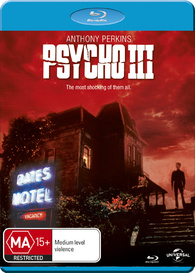Psycho III (Blu-ray) (1986) |
|
Psycho III (Blu-ray) (1986) |
|


|
| BUY IT |
| General | Extras | ||
| Category | Thriller |
Featurette-Watch the Guitar - An Interview with Jeff Fahey Featurette-Patsy's Last Night - An Interview with Katt Shea Featurette-Mother's Maker - An Interview with Michael Westmore Featurette-Body Double with Brinke Stevens Theatrical Trailer Gallery-Photo Audio Commentary-with Charles Edward Pogue |
|
| Rating |

|
||
| Year Of Production | 1986 | ||
| Running Time | 92:50 | ||
| RSDL / Flipper | Dual Layered | Cast & Crew | |
| Start Up | Menu | ||
| Region Coding | 1,2,3,4,5,6 | Directed By | Anthony Perkins |
|
Studio
Distributor |
 ViaVision |
Starring |
Anthony Perkins Diana Scarwid Jeff Fahey Roberta Maxwell Hugh Gillin Lee Garlington |
| Case | Standard Blu-ray | ||
| RPI | ? | Music | Carter Burwell |
| Video | Audio | ||
| Pan & Scan/Full Frame | None |
English DTS HD Master Audio 5.1 English DTS HD Master Audio 2.0 English Audio Commentary DTS HD Master Audio 2.0 |
|
| Widescreen Aspect Ratio | 1.85:1 | ||
| 16x9 Enhancement |
 |
||
| Video Format | 1080p | ||
| Original Aspect Ratio | 1.85:1 | Miscellaneous | |
| Jacket Pictures | No | ||
| Subtitles | English | Smoking | No |
| Annoying Product Placement | No | ||
| Action In or After Credits | No | ||
††† The decision to create so much as one sequel to Alfred Hitchcockís Psycho was risky, but the crew behind 1983ís Psycho II made it work, resulting in a strong follow-up that also stands as a terrific thriller on its own terms. Another sequel was seriously pushing it, and itís unfortunate to report that 1986ís Psycho III is a tremendous step down in quality. Although Psycho III is built on an interesting conceptual framework and further develops the story of Norman Bates, the execution is mediocre at best, resulting in a 90-minute slasher that feels closer to a Friday the 13th instalment. Nevertheless, itís a blessing that the picture is not as idiotic or as insulting as it might have been in less deft hands, and one must admire Anthony Perkinsí courage to both star in and direct the movie despite having no filmmaking experience.
††† Taking place about a month after the events of Psycho II, Norman Bates (Perkins) is still the sole caretaker of the Bates Motel, living in his familyís ancient house which stands adjacent. Falling back into mental instability, Norman keeps the rotting corpse of his ďmotherĒ in her room upstairs, and she is prone to murdering the motel guests if they do not sit right with her. Norman seeks to hire another pair of hands to help with watching over the motel, recruiting wily wannabe musician Duane Duke (Jeff Fahey). Meanwhile, a new patron has moved into the motel; troubled former nun Maureen (Diana Scarwid), who strongly reminds Norman of one of his victims, Marion Crane. As Norman and Maureen grow closer and feel a mutual attraction to one another, Normanís mother grows unhappy with their relationship. Complicating matters further, tenacious reporter Tracy Venable (Roberta Maxwell) begins snooping around, determined to uncover proof that Norman is responsible for the recent disappearances of several people.
††† From the very outset, we know that Norman is a schizophrenic murderer again, with writer Charles Edward Pogue providing a behind-the-curtain glimpse of Norman conversing with his dead mother and preparing to kill. In theory itís interesting to see this side of Norman, but Psycho III is low on surprises. Psychoís ending was groundbreaking, while Psycho II also packed a handful of shocking twists, but Psycho IIIís conclusion is unsurprising and rote, making little impact. Itís clever to turn this instalment into more of a character study, but Pogue and Perkins do not take full advantage of the set-up. Furthermore, Psycho III was never going to live up to Hitchcockís film in any capacity, but it keeps inviting comparisons. Psycho II worked because it found its own voice while subtly paying homage to the Master of Suspense, but Psycho III takes things a step further, with murders that visually recreate the death scenes in the 1960 original. Itís too awestruck with Hitchcockís film, and as a result itís not bold enough to try anything innovative. In fact, itís so awestruck with Hitch in general, as Perkins even stages a homage to Vertigo to open the picture. Psycho III is at its best when it introduces its own creative, twisted moments, including a marvellous scene in which the sheriff eats from the motelís tainted ice machine. In another perfect moment, Norman as Mother is on a rampage, but decides to straighten up a painting while pursuing his victim.
††† The true horror of Hitchcockís Psycho was its ďless is moreĒ approach, necessitated because Hitch had strict censorship guidelines to adhere to, else his movie would not be released. The Master of Suspense took the limitations in his stride, resulting in a very classy horror movie. A knife is never shown piercing the skin, with the death scenes creatively shot to compel us to mentally fill in the blanks. Psycho III, on the other hand, was created in a different time period, when gratuitous í80s slashers were rampant, hence on-screen nudity and explicit violence was not only allowed but encouraged. Perkins (bless his heart) gives it his all, but his directorial approach is too obvious and unremarkable, and consequently Psycho III lacks scares and chilling moments. Itís all a bit rote, and one must wonder what a Hitchcock-inspired virtuoso like Brian De Palma couldíve made of this project. That said, there is one aspect of Psycho III that really works: Carter Burwellís terrific synch score. Itís a far cry from Bernard Herrmannís music, but Burwellís work is nicely atmospheric.
††† Even if the film is marred by several issues, Perkinsí performance as Norman Bates is as brilliant as always has been. Norman represents an ideal antithesis to slasher movie icons; although he does commit unspeakably brutal acts of murder, heís morally conflicted about it, coming across as a man-child unable to control his mental state. You feel genuine sympathy for Norman, and though you know that he needs to be locked up again, you do not want him to be caught or arrested. Also good here is Scarwid as Maureen, while Fahey is wonderfully sleazy as Duke.
††† Psycho III is not essential viewing, and, like Psycho II, itís unable to recapture the artistry and ingeniousness of Hitchcockís original film. Psycho really did not need any sequels, and it doesnít help that this is pretty much a run-of-the-mill í80s slasher. Still, itís a worthwhile enough continuation of Psycho II, and those interested in the Bates mythos should find it to be a fun watch.
| Sharpness | |
| Shadow Detail | |
| Colour | |
| Grain/Pixelization | |
| Film-To-Video Artefacts | |
| Film Artefacts | |
| Overall |
| Dialogue | |
| Audio Sync | |
| Clicks/Pops/Dropouts | |
| Surround Channel Use | |
| Subwoofer | |
| Overall |
NOTE: To view non-R4 releases, your equipment needs to be multi-zone compatible and usually also NTSC compatible.
† † Our local release is a direct port of the Shout! Factory disc (there are only a few disc menu differences), with the same HD presentation and the same extras. A draw.
| Video | |
| Audio | |
| Extras | |
| Plot | |
| Overall |
| Review Equipment | |
| DVD | PlayStation 4, using HDMI output |
| Display | LG 42LW6500. This display device has not been calibrated. This display device is 16x9 capable. This display device has a maximum native resolution of 1080p. |
| Audio Decoder | Built in to amplifier/receiver. This audio decoder/receiver has not been calibrated. |
| Amplification | LG BH7520TW |
| Speakers | LG Tall Boy speakers, 5.1 set-up, 180W |